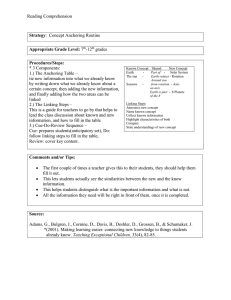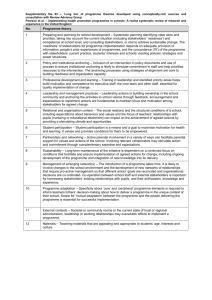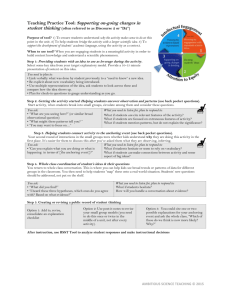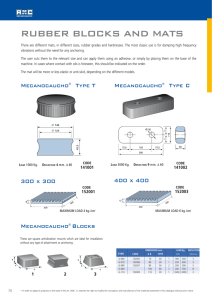Light-Induced Anchoring Transitions and Bistable Nematic
advertisement
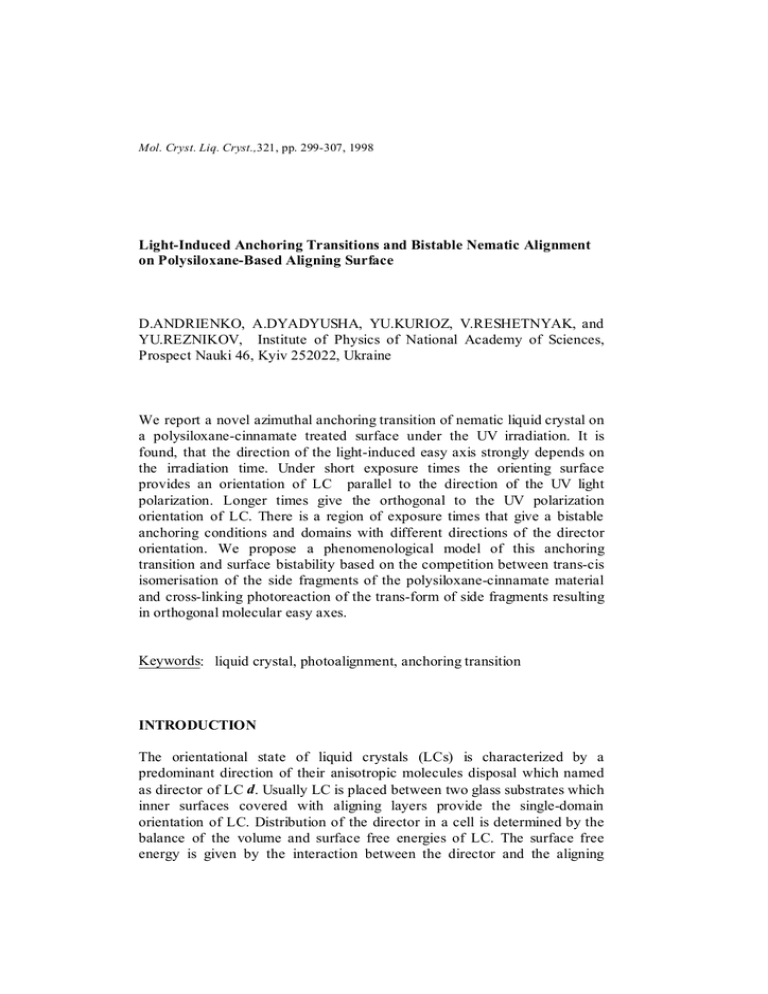
Mol. Cryst. Liq. Cryst.,321, pp. 299-307, 1998 Light-Induced Anchoring Transitions and Bistable Nematic Alignment on Polysiloxane-Based Aligning Surface D.ANDRIENKO, A.DYADYUSHA, YU.KURIOZ, V.RESHETNYAK, and YU.REZNIKOV, Institute of Physics of National Academy of Sciences, Prospect Nauki 46, Kyiv 252022, Ukraine We report a novel azimuthal anchoring transition of nematic liquid crystal on a polysiloxane-cinnamate treated surface under the UV irradiation. It is found, that the direction of the light-induced easy axis strongly depends on the irradiation time. Under short exposure times the orienting surface provides an orientation of LC parallel to the direction of the UV light polarization. Longer times give the orthogonal to the UV polarization orientation of LC. There is a region of exposure times that give a bistable anchoring conditions and domains with different directions of the director orientation. We propose a phenomenological model of this anchoring transition and surface bistability based on the competition between trans-cis isomerisation of the side fragments of the polysiloxane-cinnamate material and cross-linking photoreaction of the trans-form of side fragments resulting in orthogonal molecular easy axes. Keywords: liquid crystal, photoalignment, anchoring transition INTRODUCTION The orientational state of liquid crystals (LCs) is characterized by a predominant direction of their anisotropic molecules disposal which named as director of LC d. Usually LC is placed between two glass substrates which inner surfaces covered with aligning layers provide the single-domain orientation of LC. Distribution of the director in a cell is determined by the balance of the volume and surface free energies of LC. The surface free energy is given by the interaction between the director and the aligning D.ANDRIENKO, A.DYADYUSHA YU.KURIOZ et al surface. It sets the axis of an easy orientation of LC e and is characterized by the anchoring energy W defined as a work needed to deviate the director from the easy axis direction. If some parameters determining the structure of the bounding substrate or the liquid crystal are changed, the number and the location of the minimums of the interfacial energy may change, resulting in anchoring transitions and thus changes in the anchoring directions taken by the nematic phase (see B.Jerome[1]). The investigation of different types of anchoring transitions is of prime importance for a fundamental understanding of surface alignment and for device application. In particular, the change of the LC orientation under an anchoring transition may lead to drastic changes of optical characteristics of LC cell making possible to develop new types of LC devices. The most of anchoring transitions were observed by varying the LC temperature.[2-7] Other types of anchoring transitions were obtained by varying parameters, determining the structure of the substrates (density and thickness of alignment layer, length of aliphatic chains of polymer fragments, etc.).[8-10] Recent development of photoaligning polymers enables the precise surface parameters control.[11-16] Aligning ability of these materials is determined by their anisotropy properties induced by a light illumination. The easy axis direction is given by the direction of the light-induced anisotropy axis. The anchoring energy depends on the value of this anisotropy. Both the easy axis direction and anchoring energy value can be effectively controlled with the change of light characteristics (polarization, exposure time and intensity, wave length etc.) In the present paper we report the first observation of light-induced anchoring transition. It was found on the surface of polysiloxane-cinnamate (PSCN) based polymer - a representative of the promising polysiloxane photoaligning materials, developed recently.[17] The transition manifests itself as the change of the easy axis direction perpendicular to the initial one under the exposure of the actinic UV light. EXPERIMENT The experiments were carried out in combined LC cells. They were composed with two quartz substrates and LC pentylcyanobiphenyl (K15) in between. The inner surface of one substrate was covered with rubbed polyimide layer (PI). This material provides a strong anchoring of K15 with the tilt angle θ PI ≈ 2-4o with the substrate, lined along the rubbing direction. LIGHT-INDUCED ANCHORING TRANSITION The other substrate was covered with PSCN and illuminated by polarized UV-light of a high-density mercury lamp. The main spectral lines of the lamp corresponded to the absorption band of PSCN. The linearly polarized exposure light with the polarization vector Euv in the plane of polymer film was formed by the quartz lens system and the polarizing Glan-Thomson prism, rotation of which allows to control the polarization of UV-light. The typical value of the light power density I0 in the plane of polymer film was about 5 -10 mW/cm2. LC cells were assembled with the gap given by calibrated polymer spacers, 6.5µm or glue-covered polymer strips, 65µm. The substrates were added together at a given angle α between the rubbing direction of the PI layer and the direction of the UV-light polarization under which the PSCN layer was irradiated. The cells were filled due to the capillary effect at room temperature with liquid crystal in a nematic phase or slow cooled from the isotropic phase. Both methods gave the same results. We studied the alignment of LC by varying the UV light exposure time τ and the angle α. To find the direction of light-induced easy axis e uv with respect to the direction of the UV light polarization Euv we compared the alignment of LC in the pair of combined cells. The cell thickness in these experiments was chosen rather thick (65µm). Therefore, the anchoring parameter ξ=WuvL/K2 is large enough and the director on the surfaces is parallel to the easy axes. PSCN layer in the first cell was irradiated by light with Euv parallel to the long side of the substrate. This layer was irradiated with Euv perpendicular to the long side in the second cell. The rubbing direction of the PI layer was parallel to this side in both cases. The observation in the polarizing microscope shown the planar untwisted structure in the first cell and (90±1)o-twist structure in the second cell at the exposure time τ=2min. In opposite, we found the (90±1)o-twist structure in the first cell and untwisted alignment in the second cell if exposure time was 10min. Thus, we can state that the vector euv is parallel to the polarization Euv at a short exposure time while euv is normal to Euv at a long exposure. In the experiment described above the light-induced easy axis is perpendicular to the direction of rubbing, that is α=β=90o at the long exposure time and threshold reorientation should take place [3,18]. This transition cannot be considered as the anchoring transition and might hinder the interpretation of the our results. Therefore, the following experiments were carried out at the angle α=45o where the director reorientation to the light-induced easy axis is smooth. The experimental data are presented in Fig.1. It is seen that the surface director alignment strongly depends on the cell thickness. For the thick LC layer (65µm) the sharp transition between two perpendicular direction of d D.ANDRIENKO, A.DYADYUSHA YU.KURIOZ et al (from d || Euv to d ⊥ Euv) occurs near the exposure time τ = 30min. In the intermediate region we observe a polydomain planar structure which manifests itself as regions with d || Euv and d ⊥ Euv. The domains were separated with walls with the character thickness l ~ 2µm. The total square of the d || Euv -domain decreases at a sacrifice in d ⊥ Euv -domain with the exposure increase. In the thin layer (5µm) we observed the smooth changes of the director orientation on the surface. Firstly director reorients toward the vector Euv with the exposure increase. Then, beginning to turn in the opposite direction, the director aligns perpendicular to the vector Euv. Inter-domain region looks similar to observed in the thick cell but is characterized with much more thick inversion walls (l ~ 20µm). Director angle, deg 60 65 µm 6.5 µm 40 20 0 -20 -40 0 20 40 60 80 100 Irradiation time, min FIGURE 1. Dependence of the director orientation on PSCN surface on the irradiation time DISCUSSION The obtained results show that the anchoring parameters which define the surface free energy f s and the orientation of the director onto the aligning PSCN surface depend on the UV light exposure. The orienting effect of the polymer layer can be connected to an anisotropic Van der Waals interaction between LC and anisotropic distribution of the polymer fragments. The surface free energy can be LIGHT-INDUCED ANCHORING TRANSITION expanded in powers of cos2ϕ s (we take into account first two terms of this expansion) f = - ½W(I) cos2ϕs - ¼ Bcos4ϕ s, (1) where ϕ s is the deviation of the director on the aligning surface, W is the anchoring energy and the term B is connected with the effects of stochastic distribution of fragments in the orienting film.[19] The direction of the easy orientation axis can be obtained by minimizing the expression (1). The condition ∂f / ∂ϕ = 0 implies sin(2ϕ) (B cos2ϕ + W) = 0, (2) and gives three possible solutions ϕ = 0; ϕ = ½π, cos2ϕ = -W/B. These solutions determine direction of the easy orientation axis onto the photosensitive surface. Transitions between them have two possible scenarios depending on the sign of parameter B. 1. B > 0. For W < -B the equilibrium state corresponds to ϕ s = ½π. For W > 0 the stable state is ϕs = 0. For -B < W < 0 both ϕ s = 0 and ϕs = ½π solutions are stable. The intermediate solution cos2ϕ s = -W/B determines the maximum of the surface energy and is unstable. Thus, we have jump-like transition with hysteresis between the stable solutions ϕs = 0 and ϕs = ½π (Fig.2a). 90 75 90 ϕs B>0 75 60 60 45 45 30 30 15 15 0 0 -2 -1 0 W 1 2 % ϕs -2 -1 0 1 2 W a) b) FIGURE 2. Possible behavior of the easy axis in the intermediate region. a) jump-like, b) smooth reorientation of easy axis direction. 2. B < 0. In this case for -B < W < 0 both ϕ s = 0 and ϕ s = ½π solutions are unstable and the solution cos2ϕs = -W /B presents the intermediate azimuthal D.ANDRIENKO, A.DYADYUSHA YU.KURIOZ et al orientation of the easy axis. Thus, the smooth reorientation of the easy axis direction takes place (Fig.2b). The anchoring transition of such kind was observed recently by Barberi et al[20] on a composite surface made with a film of photopolymer on an anisotropic SiO layer. In both cases the region -B < W < 0 defines the critical state when the orienting anchoring competition begins to take place. Thus, we can describe our experiments if we assume that the sign of the anchoring energy changes during the UV exposure. The observation of the two-domain structure allows to state that the interfacial region for the PSCN - K15 is characterized by the parameter B > 0. Indeed, let us assume that anchoring energy of the untreated PSCN surface is negligibly small. Then the director orientation in the cell and on the PSCN surface should be given by the reference substrate, i.e., ϕ s = 0. The UV-irradiation causes appearance of the easy axis euv parallel to the polarization vector, i.e., W >0 and the director turns toward to the euv. Growth of the angle ϕ s under the increase of the exposure in the thin cell noted for the increase of the anchoring energy value W at the beginning of the exposure. Passing through the maximum, the reorientation angle turns back, i.e., W decreases approaching the transition region. Crossing this region, the reorientation angle changes its sign and the director starts to line up normal to Euv. This means that the anchoring energy changes the sign and its absolute value increases. The change of the sign of the anchoring energy value under UV irradiation can be naturally explained, taking into account the microscopic mechanisms of the photoalignment effect on PSCN surface. Its structure is similar to the structure of well known photo-aligning material polyvinyl-cinnamate which polyvinyl-alcohol main chain is substituted with a polysiloxane one, and photosensitive side groups contain a cinnamic acid fragment (Fig. 3). So, it is reasonable to suppose that the photochemical reactions resulting in a lightinduced anisotropy in PSCN and polyvinyl-cinnamates are similar. There are two main photochemical reactions involving the cinnamate groups.[14] First, these groups may crosslink under the action of UV light. The crosslinking induced by unpolarized UV light results in the formation of anisotropic trans-cyclobutane photoderivatives, although the materials itself remains isotropic. Under polarized UV light the side fragments with long axes preferentially parallel to the polarization direction Euv undergo extensive crosslinking and the material becomes anisotropic. Second, the cinnamate groups may undergo consequent trans-cis-trans-… isomerisation during UV irradiation. This process leads to the reorientation of trans-isomers perpendicular to the polarization of UV light and results in the appearance of LIGHT-INDUCED ANCHORING TRANSITION the anisotropy as well. In addition, the appearance of cis-isomers of the cinnamic fragments may cause the anisotropy of the material. CH3 CH3 O Si R CO2 O Si ( CH2) 3 (CH2) 3 CH CH O O R O (CH2) 3 CO 2 CH CH O Si CH CH CO2 R CO 2 CO2 R R CH3 O (CH2) 3 O (CH2) 3 O Si Si O CH3 CH3 trans-cis (E/Z) isomerisation cross-linking (photodimerization) FIGURE 3. Photochemystry of PSCN. The direction of the easy axes induced by cross-linking and trans-cis mechanisms is determined by the angular anisotropic interaction between LC molecules and initial and phototransformed cinnamate groups. Usually the crosslinking of cinnamates results in photoproduct with long axis perpendicular to the vector Euv. In our case the specific displacement of the cinnamate group with respect to the main polymer chain determines long axis parallel to the vector Euv (Fig.3). Thus, it is reasonable to suppose that the easy axis provided by cross-linking mechanism is parallel to Euv. In opposite, the trans-cis isomerisation results in the reorientation of transcinnamate groups normally to the polarization of the UV light and provides the easy axis perpendicular to Euv. Thus, we have two microscopic mechanisms which are characterized with anchoring energies of opposite signs. Dynamics of the light-induced anisotropy and characteristic times of these mechanisms are different, i.e., the competition between them causes the observed anchoring transition. The microscopic investigation of the observed anchoring transition deserves further studies. D.ANDRIENKO, A.DYADYUSHA YU.KURIOZ et al CONCLUSIONS The novel azimuthal anchoring transition of nematic liquid crystal on a polysiloxane-cinnamate treated surface under the UV irradiation was found. It manifests itself as the change of the direction of the light-induced easy axis to the perpendicular orientation with the increase of the exposure. There is a region of exposure times that give a bistable anchoring conditions and domains with different directions of the director orientation. The phenomenological model of this anchoring transition and surface bistability based on the competition between trans-cis isomerisation and cross-linking photoreaction anisotropy induction of PSCN derivatives is proposed. Acknowledgments The research described in this publication was made possible in part by Grant No. 2.4/923 from the Ukrainian State Fund for Fundamental Studies Support and Grant No. UE1-315 of CRDF Cooperative Grants Program. References [1.] Blandine Jerome, Rep.Prog.Phys., 54, 391 (1991) [2.] G.Reschenkov, M.Kleman, J.Chem.Phys., 64, 404 (1976) [3.] G.A. Di Lisi, Ch.Rosenblatt, A.C.Griffin, U.Hari, Liq.Cryst., 7, 353 (1990). [4.] J.Patel, H.Yokohama, Nature, 362, 525 (1993) [5.] G.E.Volovik, O.D.Lavrentovich, Sov.Phys.JETP, 58, 1159 (1983). [6.] H.Birecki, Lij.Cryst.Ordered Fluids, 4, 853 (1983). [7.] V.G.Nazarenko, O.D.Lavrentovich, Phys.Rev.E, 49(2), 990 (1994). [8.] K.Hitrop, H.Stegermeyer, Mol.Cryst.Liq.Cryst.Lett., 49, 61 (1978). [9.] L.Komitov, S.T.Lagerwall, A.Sparavigna, B.Stebler, A.Strigazzi, Mol.Cryst.Liq.Cryst., 223, 197 (1992) [10.] K.Flatischler, L.Komitov, S.T.Lagerwall, B.Stebler, A.Strigazzi, Mol.Cryst.Liq.Cryst., 198, 119 (1991). [11.] A. Dyadyusha, V. Kozenkov, T. Marusii, Yu. Reznikov, V. Reshetnyak, A. Khizhnyak, Ukr. Fiz. Zh., 36, 1059 (1991). [12.] M. Schadt, K. Schmidt, V. Kozenkov, and V. Chigrinov, Jpn. J. Appl. Phys. 31, 2155 (1992). [13.] T. Marusii and Yu. Reznikov, Mol. Mat. 3, 161 (1993). [14.] J.L.West, X.Wang, Y.Ji and J.R.Kelly, Proceedings of the SID Digest of Technical papers, 703 (1995). LIGHT-INDUCED ANCHORING TRANSITION [15.] Yu.Reznikov, R.Petchek, Ch.Rosenblatt.. Appl.Phys.Lett. 68(16), 2201 (1996). [16.] K.Ichimura, Y.Akita, H.Akiyama, K.Kudo, Jpn.J.Appl.Phys., 35, L992 (1996). [17.] O.Yaroshchuk, G.Pelzl, G.Pirwitz, Yu.Reznikov, H.Zaschke, J.H.Kim.S.B.Kwon, Japanese Journ.Appl.Phys., 36(9), 961 (1997). [18.] D.Voloshchenko, A.Khizhnyak, Yu.Reznikov, V.Reshetnyak. Jap.Journ.Appl.Phys. 34, 566 (1995). [19.] A.L.Alexe-Ionescu, R.Barbero, Z.Gabbasova, G.Soyko, A.K.Zvezdin, Phys.Rev.E, 49, 5354 (1994). [20.] R.Barberi, A.L.Alexe-Ionescu, J.J.Bonvent, M.Giocondo, M.Iovane, to be published, Appl. Phys. Lett. (1997).
